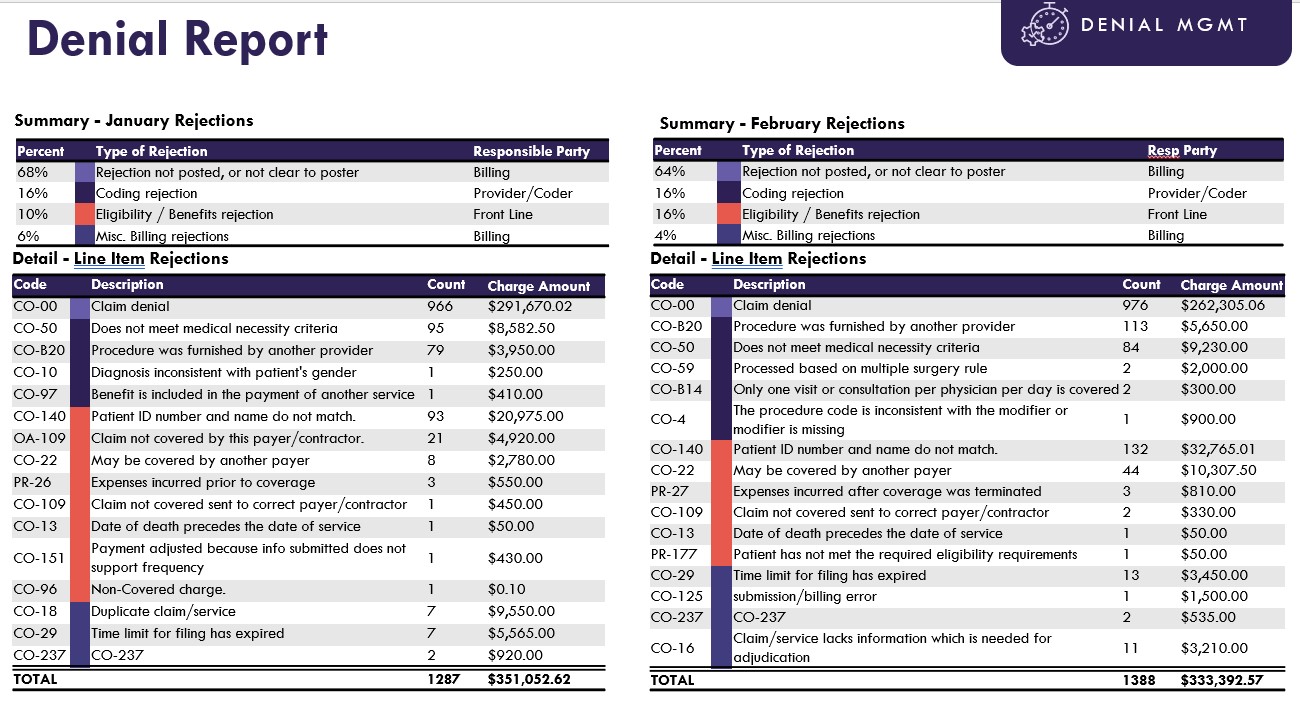The 3 Keys to Denial Reduction: People, Process, & Technology

Written by: Cheryl Reifsnyder, PhD and Sandi Soucy, Vice President Solutions Management, Veradigm
In a recent poll from the Medical Group Management Association (MGMA), 41% of medical group leaders reported finance and revenue cycle management as their biggest projects for 2024. Why the financial focus? One reason is that healthcare practices struggle with staffing shortages, especially in billing, coding, and collections. At the same time, inflation continues to pressure practices’ bottom lines; 9 of 10 practices reported costs rising faster than revenue. Practices’ financial situation has been further exacerbated by growing numbers of unresolved claim denials. Denial rates have been increasing in recent years—69% of healthcare leaders reported an increase in denials in 2021, and respondents to an MGMA Stat poll reported that denials increased by an average of 17% in 2021.
Claim denials have become one of the most common barriers to effective revenue cycle management. Dealing with them demands both time and resources, and they delay payments and disrupt your practice’s cash flow. That’s why reducing the number of denied claims is crucial to improving your practice’s revenue cycle.
Approximately 90% of denied claims are preventable—meaning that practices can prevent denials before they happen, potentially preventing lost revenue and saving staff hours. Some claims will still be rejected, but as many as 2/3 of those can be recovered. Despite that, up to 65% of denied claims are never resubmitted.
To reduce claim denials, we need to examine all the elements that potentially contribute to denials—and these elements can be grouped into 3 categories, creating a framework to help you improve denial prevention and decrease the number of denials overall: the People, Process, and Technology (PPT) framework. Keep reading to learn how this framework can help reduce denials for your practice.
People
People make up one of the 3 essential elements to consider when working to reduce your practice’s denial rate. Numerous stakeholders are involved in denial prevention, from practice management to providers to front and back office workers. Here, we will focus on 2 groups with perhaps the greatest influence on the process: front and back office staff.
Front office staff
Many don’t realize how much front office staff influences a practice’s denial rate, but inaccurate or incomplete patient information collected at the front end can set the stage for denial even before the patient’s visit. Nearly 27% of claim denials can be traced to patient registration and eligibility.
Front desk staff require a unique skill set. In addition to customer service skills, they must also understand the nuances of insurance policies and how to communicate this information to patients.
Staff training is crucial for your regular front office staff as well as for those who might occasionally “fill in.” Imagine this scenario: The waiting room is packed, with only one person checking in patients, and another person jumps in to help. If this “helper” isn’t trained, their check-in is likely to have errors or missing information. This scenario becomes even more likely if your practice is short on staff, causing your existing workforce to wear many different hats.
Back office staff
Billing and coding staff have an obvious role in denial prevention, as even the smallest billing and coding errors can result in claim denials or payment delays, negatively impacting practice revenue. A recent survey identifies denial management as the single aspect of revenue cycle management requiring the greatest subject matter expertise. It can be challenging for billing staff to stay on top of the ever-evolving regulatory requirements and payers’ changing reimbursement requirements in order to submit claims correctly the first time.
To improve your practice’s denial rate, it’s essential to evaluate if and how your staff is receiving ongoing, in-depth training to help them stay current with regulatory changes and changes to payers’ reimbursement requirements.
Beyond staff
Identifying the stakeholders and ensuring they receive proactive training are valuable steps in denial prevention—but what happens when denials still occur? To determine precisely where problems are occurring, you need established processes with codified steps for where, exactly, issues exist that contribute to claim denials.
What if you’re short staffed?
As staff shortages continue to be a challenge, many healthcare organizations are turning to revenue cycle services. If your organization is experiencing one of the following issues, it may be time to look for a helping hand:
- Growing and aging accounts receivable
- Denials that are not receiving follow up
- Inability to keep up with changes in regulatory or payer requirements
Outsourcing revenue cycle services can help practices capture the revenue they’re owed. Some questions to ask when outsourcing include:
- What are the vendor’s net collections and first-pass clean claims rates?
- Does the vendor provide teams not just to manage day-to-day tasks, but also to manage your revenue cycle action plan and ensure key performance indicators are being met?
- Does the vendor provide access to revenue cycle data and analytics?
For instance, Veradigm Revenue Cycle Services provides professional billing experts who collaborate with organizations at every step of the revenue cycle to ensure accurate billing and coding—helping boost efficiency and productivity, increase cash flow, and improve your practice’s bottom line.
Process
People and Technology are both essential elements of the PPT framework and are both essential for reducing denials. However, they can only be fully effective when paired with ongoing process improvements—process improvements that incorporate insights provided by Technology and implemented by People.
IMMP
One well-known process for systematic management and prevention of claim denials is known as Identify, Manage, Monitor, Prevent (IMMP):
- Identify: This step focuses on identifying the root causes of claims denials.
- Manage: An effective and efficient management process requires standardized workflows and utilization of software tools (such as practice management software) to sort denials by amount, time, reason, and so on to make the process more efficient.
- Monitor: To avoid missing deadlines or losing track of claims-in-progress, keeping accurate records of denials is essential.
- Prevent: After gathering relevant data regarding claims denials, this step focuses on determining measures to reduce future denials.
Although all 4 of these steps are essential for denial management, we will focus on the first and last as the most relevant to pinpointing and avoiding preventable claim denials.
Identify: To avoid reworking the same types of denials over and over, you need to know what denials are coming in and why. Successfully identifying the root cause of denials requires:
- An established process for identifying and addressing denials
- A team in place with members from all departments, collaborating to identify root causes
- Access to data (both real-time and historical) and analytics
Prevent: The purpose of identifying the root causes of denials is to determine what steps to take to reduce future denials, such as retraining staff, adjusting workflows, or revising processes. Taking preventive measures as early as possible in the revenue cycle is much less expensive than reworking claims after denial.
For instance, identifying the root causes of denials enables you to re-train business areas behind these denials. Sort denials by responsibility and share actual data with the responsible stakeholders so they can see their impact on the revenue cycle.
The IMMP process relies heavily on data and analytics for its success—which is why reporting is another step essential to your denial reduction process.
Reporting
Data and analytics are crucial for identifying the root cause of a denial. Your established process should include monthly reports of detailed data on all claims that are initially rejected, which will allow you to identify trends that can be avoided in the future. Reporting enables you to:
- Identify root causes of denials, enabling you to implement effective preventive measures
- Identify trends, which can help you identify issues causing denials
- Identify responsible parties and reveal the financial impact of these parties
- Re-evaluate workflows
- Simplify the appeals process
- Track progress so you can identify areas that are doing well versus those that aren’t

For instance, this summary of January and February rejections is one of the reports available from Veradigm Revenue Cycle Analytics:
This report identifies stakeholders, allowing you to identify where rejections are coming from. It also includes remit and remark codes, helping you evaluate each denial’s cause.
Reporting is key because it provides information enabling you to address issues with staff—and staff won’t realize they need to make changes if they don’t see how they are affecting revenue.
You may have noticed that every process discussed for denial prevention relies on technology for its success. Technology is the tool enabling you to identify the source of claim denial problems, helping you pinpoint exactly which stakeholder, workflow, or process needs to be addressed to reduce your denial rate.
Technology
About 31% of healthcare practices still use manual processes for managing denials. However, technologies such as practice management software are available to help prevent, handle, mitigate, and track denials. The best practice for denial prevention and management is to use a solution that can:
- Easily manage and track claim denials
- Sort denials by billing, coding, and front office errors—helping you determine what type of issue each is so you can reach resolution more quickly
- Drill down denials to the root cause
- Compare your performance against nationwide averages and peer statistics
The right practice management software is a key element of denial prevention because it automates and streamlines the practice’s administrative and billing functions. However, choosing a practice management system that fits your needs, is well supported, and is compliant can be daunting.
Here are some key questions to help you select the best practice management solution:
- Does the vendor provide their clean claims rate?
- What kind of automation does the solution provide?
- What kind of training and support does the vendor offer?
- How many years’ experience does the vendor have?
The 3-part framework
Reducing denials is crucial for improving your practice’s financial position. The PPT framework is key to accomplishing this—and Veradigm can provide the best-in-class PPT to aid your practice’s goal of reducing claim denials:
- People: Supplement the people in your equation with Veradigm Revenue Cycle Services, a comprehensive suite of revenue cycle services solutions to support your practice’s success. Our delivered outcomes include 98% net collections, 98% first-pass clean claims rate, and an average of 2% to 5% improvement in revenue for our clients.
- Process: For process, harness our experience optimizing workflows, as demonstrated by that 98% first-pass clean claims rate.
- Technology: For technology, we provide Veradigm Practice Management is a comprehensive revenue cycle management solution for physician practices of all sizes and specialties that can help boost operational efficiency and productivity. Veradigm Practice Management enables better reporting and denial management by providing access to real-time information on charges, payments, claim status, A/R aging, and coding trends.
Contact us today to learn how Veradigm can help your practice reduce your denial rate—and improve your practice’s overall financial situation.